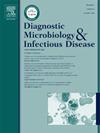Co-infection of intestinal protozoa and intestinal parasites with Helicobacter pylori among HIV AIDS patients at Jimma Medical Center, Ethiopia
IF 2.1
4区 医学
Q3 INFECTIOUS DISEASES
Diagnostic microbiology and infectious disease
Pub Date : 2025-03-08
DOI:10.1016/j.diagmicrobio.2025.116789
引用次数: 0
Abstract
Background
Human Immunodeficiency Viruses (HIV) infected people are at increased chance of immunocompromission. In combination with this immunocompromission, the incidence of co-infection with intestinal parasites, intestinal protozoal and Helicobacter pylori can be escalated by different factors including similar mode of transmission, poor economic status, synergistic pathogenesis, and geographic topography of more than two organisms. A large number of world population is either affected or at risk of infection from diversified intestinal parasites, intestinal protozoal and H. pylori.
Objective
The study determined the prevalence of H. pylori with intestinal parasites and intestinal protozoal co-infection among HIV positive individuals and factors associated to the co-infection at Jimma University Medical Center (JUMC); Jimma, Ethiopia.
Materials and methods
This cross-sectional study included 384 HIV positive patients using consecutive sampling technique. Stool sample was examined using normal saline to diagnosis intestinal parasites and with lugol's Iodine for active motile intestinal protozoa and the stool sample was concentrated by formalin-ethyl acetate and stained with Kinyoun-modified acid-fast stain to stain coccidian protozoa H. pylori was diagnosed by antigen test using Wondfo one Step H. pylori feces test.
Result
In this study, gender distribution was 177(46.1 %) males and 207(53.9 %) females. About 179 were between 10 and 20 years. The prevalence of H. pylori, intestinal parasites and intestinal protozoal infection among HIV positive individuals were 27.6 % 24.4 % and 6.5 % respectively. The overall prevalence of both intestinal parasites and intestinal protozoal co-infection with H. pylori was 20.7 %. Positive associations of co-infection with source of drinking water, animal contact, finger nail trimming, economic status and shoe-wearing habits as significant variables.
Conclusion and recommendation
A notable co-infection involving H. Pylori alongside intestinal parasites and intestinal protozoa was identified. It was acknowledged that the sanitary and socio-economic conditions could serve as potential risk factors associated with co-infection. Enhancing hygiene and sanitation practices is essential to interrupt the transmission pathways of intestinal parasites, H. Pylori, and intestinal protozoa, particularly for individuals with weakened immune systems, including those living with AIDS.
埃塞俄比亚Jimma医疗中心艾滋病患者肠道原生动物和肠道寄生虫与幽门螺杆菌的共同感染
背景人类免疫缺陷病毒(HIV)感染者出现免疫功能低下的几率增加。在免疫力下降的同时,肠道寄生虫、肠道原生动物和幽门螺旋杆菌的合并感染率也会因不同因素而上升,这些因素包括相似的传播方式、经济状况不佳、协同致病机制以及两种以上生物的地理分布。该研究确定了埃塞俄比亚吉马市吉马大学医疗中心(JUMC)的艾滋病毒阳性者中幽门螺杆菌与肠道寄生虫和肠道原虫合并感染的流行率以及与合并感染相关的因素。粪便样本用生理盐水检测以诊断肠道寄生虫,用鲁戈尔碘检测活跃蠕动的肠道原虫,粪便样本用福尔马林-醋酸乙酯浓缩,用 Kinyoun 改性酸-牢度染色法染色以检测球虫原虫 H. Pylori(幽门螺杆菌)。结果 在这项研究中,性别分布为男性 177 人(46.1%),女性 207 人(53.9%)。约 179 人的年龄在 10 至 20 岁之间。艾滋病毒阳性者中幽门螺杆菌、肠道寄生虫和肠道原虫感染率分别为 27.6% 24.4% 和 6.5%。肠道寄生虫和肠道原虫与幽门螺杆菌合并感染的总发病率为 20.7%。幽门螺杆菌与肠道寄生虫和肠道原生动物的共感染与饮用水源、动物接触、修剪指甲、经济状况和穿鞋习惯等重要变量呈正相关。人们认识到,卫生和社会经济条件可能是与合并感染相关的潜在风险因素。加强个人卫生和环境卫生对于阻断肠道寄生虫、幽门螺杆菌和肠道原生动物的传播途径至关重要,尤其是对于免疫系统较弱的人,包括艾滋病患者。
本文章由计算机程序翻译,如有差异,请以英文原文为准。
求助全文
约1分钟内获得全文
求助全文
来源期刊
CiteScore
5.30
自引率
3.40%
发文量
149
审稿时长
56 days
期刊介绍:
Diagnostic Microbiology and Infectious Disease keeps you informed of the latest developments in clinical microbiology and the diagnosis and treatment of infectious diseases. Packed with rigorously peer-reviewed articles and studies in bacteriology, immunology, immunoserology, infectious diseases, mycology, parasitology, and virology, the journal examines new procedures, unusual cases, controversial issues, and important new literature. Diagnostic Microbiology and Infectious Disease distinguished independent editorial board, consisting of experts from many medical specialties, ensures you extensive and authoritative coverage.

 求助内容:
求助内容: 应助结果提醒方式:
应助结果提醒方式:


